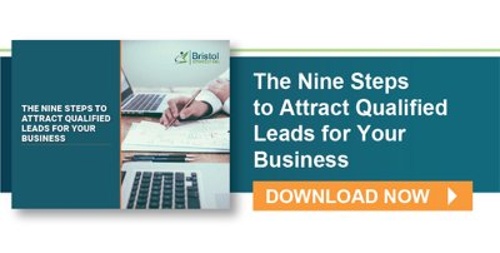For business owners operating in this digital age, lead generation is a vital component to achieving sustainable success. Just as blood must continually circulate throughout the body in order for a person to remain healthy, a company must maintain a constant flow of lead generation in order to remain financially viable. And of course, the bulk of lead generation in today's world comes from Web-based traffic.
How can your company create, optimize, and implement a successful online lead generation strategy? This article will focus on some key drivers for any good lead generation plan, and how you can leverage them to your advantage.
The Importance of SEO and Content
SEO-driven content is the fundamental building block for any effective online lead generation strategy. Search engine optimized content guarantees a greater probability of converting visitors into leads, and eventually leads into customers. In fact, 91.5% of all organic traffic lands on one of the websites listed on Google's first page of search results. That's huge!
The tricky thing about generating exceptional content is that it really must address two audiences at the same time: your consumer base, and the search engine. A truly well-written piece of content will not only show up as a top search result (sooner or later), but will also provide real, actionable value to your visitors.
Thus, as we dive into ways to leverage content for enhanced lead generation, keep the following principles in mind:
- Write content first and foremost for your human audience. While it is important to incorporate target keywords into your content, don't fall prey to the trap of awkward keyword "stuffing." Such a blatant power play for a higher Google SERP ranking will not only alienate your users, but often backfires, as the Google algorithm will penalize websites for this and other shady practices.
- Ensure that your content is always on-topic. For example, if you publish an article with the theme: "5 Ways to Evaluate Your Stapler's Performance," then a paragraph about how to use a hole-punch would probably be irrelevant to your searcher's intent. Remember, Google filters its search results, in part, based on relevance.
- Always make your call to action (CTA) clear, simple, and visible. Don't assume that your consumers know what to do with the information you've provided to them. A simple CTA with a focused objective can work wonders for lead generation.
- Above all else, always provide accurate and valuable information to your consumers. This will aid your SEO score; Google offers more weight to "authoritative" websites (in other words, websites that Internet users share, link to, or otherwise reference as helpful) than websites that have few "votes of confidence" from the online community. More importantly, by means of such high-quality content your brand will slowly develop a priceless bond of trust with your target audience.
Now, let's talk about how to leverage content for optimized lead generation. The classification of consumers according to "funnel stage" plays a huge role in such efforts.

Optimizing Content According to Funnel Stage
We all know that the sales/marketing funnel has 3 main stages:
- Top of funnel (ToFu). This is the stage at which prospects are not actively interested in purchasing a product or service. Actually, many buyers at this stage are unaware of either a problem that they currently have, or possible solutions to that problem.
- Middle of funnel (MoFu). At this point, the prospect has become aware of both his or her current problems, and at least some of the potential solutions available on the market. Now the prospect is beginning to evaluate the options. This is the stage in the funnel at which companies can turn prospects into actual leads.
- Bottom of funnel (BoFu). At this point in the buyer's journey, he is ready to make an informed purchase decision. This is when businesses must deliver "seal-the-deal" type content in order to convert the lead into an actual customer.
Companies that are highly successful at generating productive leads produce content for buyers at each stage of the funnel. For instance:
- A company that sells dog food may publish a ToFu-focused article that provides a basic overview of which nutrients dogs need in order to remain at peak health.
- For consumers in the middle of the funnel (those wanting to evaluate the different dog food brands on the market), the same company may deliver a piece of content that compares and contrasts their product with similar offerings from the competition. At the end of the article, there is a CTA for interested prospects to input their email address in exchange for a free eBook.
- Finally, the dog food company may offer leads at the bottom of the funnel the chance to try their product on a free trial basis; or they may publish glowing testimonials from current customers. The ultimate goal is to seal the deal, and convert the lead into a satisfied customer.
Define and Target the "Ideal Customer"
As you work to generate content for consumers in each funnel stage, it's important to consider another key ingredient for successful lead generation: the buyer persona.
A buyer persona is basically a semi-fictional profile of your company's "ideal customer." In other words, if you had to describe someone that would be intensely interested in your product, and that would be an excellent lifelong customer, what would that someone look like?
Whereas funnel-optimized content allows you to more effectively target consumer segments, an accurate buyer persona informs the tone and sensibility of your content. In effect, it helps your content appeal to individuals instead of groups.
Forbes offers an excellent example of how creating and implementing a buyer persona can benefit a company. Imagine that you name your ideal customer "Sally," and that during your research for this buyer persona you discover that Sally dislikes brash colors and aggressive language. Would you use fluorescent pink colors to market your product, or taglines like: "Don't give up until your day is crushed?" Probably not!
Clearly, combining a well-researched buyer persona with funnel stage-specific content offers an unbeatable one-two punch for effective lead generation.
Define and Implement a Lead Capture Strategy
Once you have established clear "best practices" for your content, you should give attention to another important avenue for generating leads. In order to truly leverage the value that your content is providing, it is important to define and implement a lead capture strategy.
Such strategies typically involve a combination of marketing/lead generation tactics, such as:
- Lead magnets. These are ways to generate leads in exchange for something of value shared with your consumers. For instance, in the dog food example mentioned above, the company's MoFu content included the offer of a free eBook in exchange for the prospect's email address. Other magnets could feature webinars, special discounts or offers, or other value-adding incentives.
- Lead scoring. Lead scoring is a way to prioritize leads, primarily based on level of interest (although other factors are also involved). A lead that downloads an eBook, subscribes to a newsletter, or watches a product overview video, for example, would score as a high priority by this measure.
- Landing page optimization. Landing pages can include any page to which a customer is redirected after engaging with a piece of content. Once you've got the customer there, it's important to move him or her further along the funnel. Landing page optimization techniques allow you to do just that.
"How can I generate more leads?" is a question that many business owners around the world ask themselves on a daily basis. This article has provided an overview of how to effectively leverage content to generate more leads. It also reviewed some key principles and guidelines that will help you to optimize your lead generation strategy.
Of course, when it comes to lead generation, this is only the beginning! If you'd like to take a deeper dive into the secrets of generating leads, then download our free eBook, "9 Steps to Attract Qualified Leads for Your Business."


